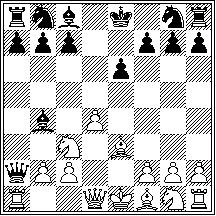Ambiguous Chess
Rules
Instead of playing his move, each player just points at a free or occupied square he intends to move to ; of course, he must have at least one piece able to reach that square. Then the opponent chooses which one of the possible pieces will indeed move to that square. If only one piece can move to the indicated square, the opponent has nothing to choose and the move can be played at once. As usual, castling is considered as a king move. No check or checkmate, one wins by capturing the opponent's king.
Notes
If one prefers to play for checkmate, the above rule translates as follows : a checkmate is a check which cannot be parried, when the three ways to parry a mate are :
- Capture the checking piece (if only one piece is checking).
- Move the king on a square where it is not in check AND where no other piece of the player could move to (otherwise the opponent would force this piece to move instead of the king, and capture the latter).
- Block the checking line, but more than one square away from the king (otherwise the opponent would force the king to move), and on a square where none of the player's pinned pieces can move to (otherwise the opponent would force the pinned piece to move).
In this case, it is also possible to play with the stalemate rule - but with the original rules, a stalemate is a win "by forced suicide" for the stalemating player.
If the game is to be played with a clock, the following procedure seems more practical : one plays a move normally and presses the clock. Then in the course of his thinking the opponent may retract the played move and move another piece on the same square before playing his actual move.
Sample Game
1.e4 e5 No choice is possible up to now. 2.Bc4 This move is a mistake... by Black ; Black could and should have chosen to push the white pawn on c4 instead. 2...d6 White could also have moved the black bishop on d6. 3.Bxf7+! No choice, the bishop was the only piece able to take that pawn. 3...Kxf7 4.Qh5! and Black is already mated. A king move is impossible, because all neighbouring squares can be reached by other pieces. If for instance Black points to e6, White will move the bishop c8 there and take the king. On the other hand, trying to move the pawn to g6 is no better defence, because White would then force the king to move on g6 and capture it.
Playing Tips
Early checks are very dangerous : the king will be unlikely to have a flight square which can be reached by it only, and on the other hand, blocking the check with a piece will pin it, what is generally a lasting handicap, as it forbids to play on any of the squares which the pinned piece can reach. A striking example : 1.e4 e6 2.d4 d5 3.exd5 Qxd5 White would have been better inspired to choose 3...exd5 instead. 4.Be3? Anticipates Qe4+, but an even more dangerous check was threatened. 4...Bb4+! 5.Nc3 The only move. 5...Qxa2!

The queen cannot be taken, because Black could choose it to be taken with the pinned knight. But White is now completely lost ! The b2 pawn cannot be defended (on c1 Black would move the white rook, and of b1 of course the pinned knight), so there will simply follow 6...Qxb2 and mate by 7...Q or Bxc3. White can only delay his fate by some moves, for instance by playing Ra3.
Variant
In Unambiguous Chess, moving to a square which can be reached by more than one piece is illegal. This implies for instance that a double check is in fact not a check at all, because the move taking the king would then be illegal.